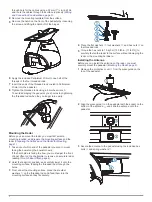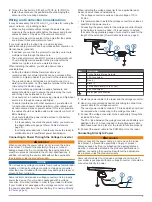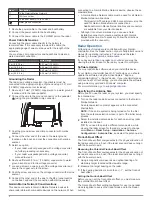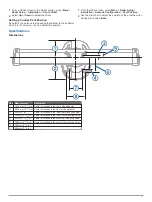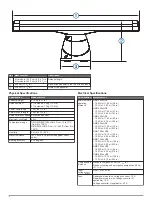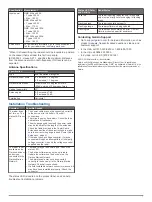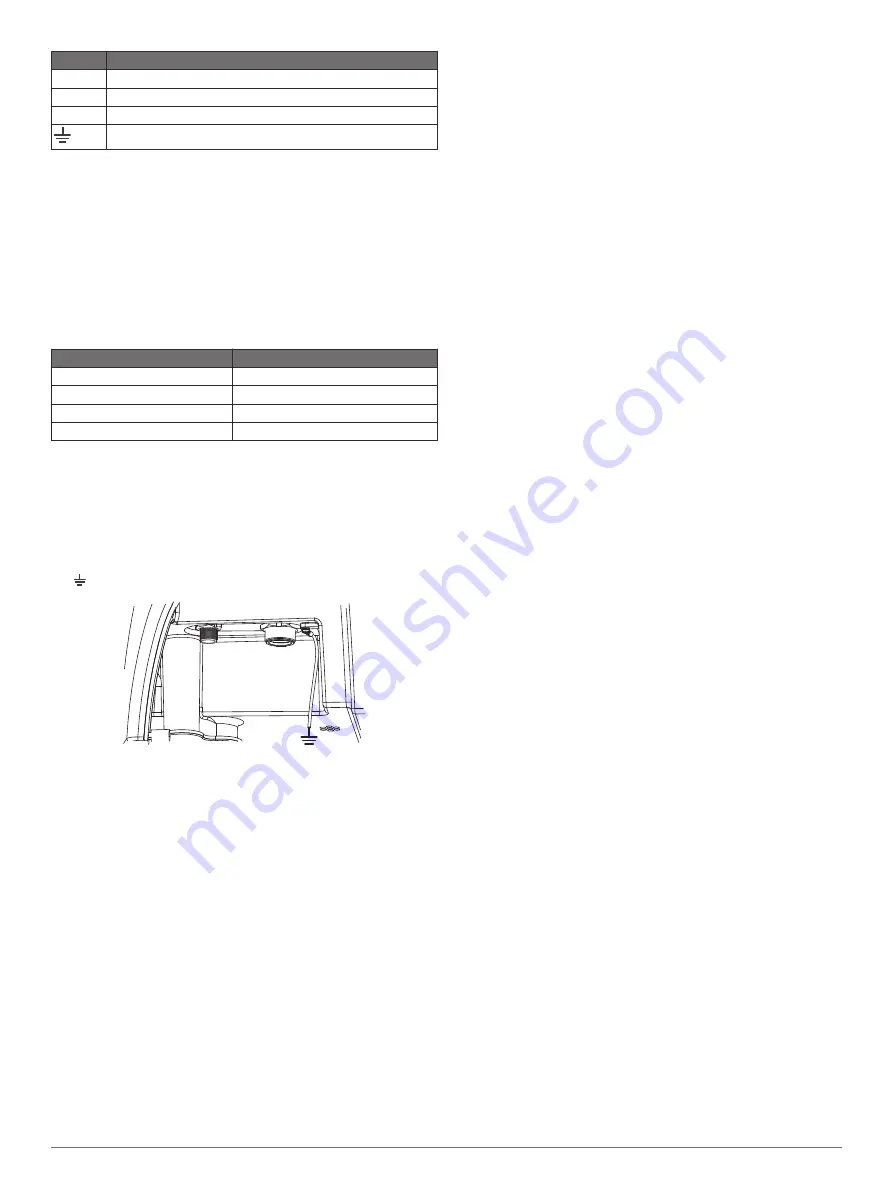
Item
Description
À
To the Garmin Marine Network
Á
15 A fuse holder
Â
To the boat battery (10 to 32 Vdc)
Water ground connection
1
Route the power cable to the radar and boat battery.
2
Connect the power cable to the boat battery.
3
Connect the power cable to the POWER port on the radar.
Power Cable Extensions
Connecting the power cable directly to the battery is
recommended. If it is necessary to extend the cable, the
appropriate gauge of wire must be used for the length of the
extension.
You must use crimp connectors and heat-shrink to create a
water-resistant connection.
Distance
Wire Gauge
3 m (9 ft. 10 in.)
3.31 mm² (12 AWG)
5 m (16 ft. 4 in.)
5.26 mm² (10 AWG)
6.5 m (21 ft. 3 in.)
6.63 mm² (9 AWG)
8 m (26 ft. 2 in.)
8.36 mm² (8 AWG)
Grounding the Radar
The radar (and voltage converter, if applicable) must be
connected to the appropriate type of ground using a 3.31 mm²
(12 AWG) copper wire (not included).
1
Route a 3.31 mm² (12 AWG) copper wire to a water ground
location and to the radar pedestal.
2
Connect the wire to the ground connector on the pedestal
( ) using the pre-installed crimp connector.
3
Coat the ground screw and crimp connector with marine
sealant.
4
Connect the other end of the wire to the water ground
location on the boat, and coat the connection with marine
sealant.
5
Select an option:
• If your radar was not packaged with a voltage converter,
no further grounding is necessary.
• If your radar was packaged with a voltage converter,
proceed to step 6.
6
Route a different 3.31 mm² (12 AWG) copper wire to water
ground location and to the voltage converter.
7
Loosen a screw on one corner of the voltage converter and
secure the copper wire to the screw.
8
Coat the screw and wire on the voltage converter with marine
sealant.
9
Connect the other end of the wire to the RF ground location
on the boat, and coat the connection with marine sealant.
Garmin Marine Network Considerations
This device connects to Garmin Marine Network devices to
share radar data with compatible devices on the network. When
connecting to a Garmin Marine Network device, observe these
considerations.
• A Garmin Marine Network cable must be used for all Garmin
Marine Network connections.
◦ Third-party CAT5 cable and RJ45 connectors must not be
used for Garmin Marine Network connections.
◦ Additional Garmin Marine Network cables and connectors
are available from your Garmin dealer.
• Although it is not recommended, you can use a field-
installable connector to create a custom-length Garmin
Marine Network cable if necessary. Follow the directions
provided with the connector.
Radar Operation
All functions of this radar are controlled with your Garmin
chartplotter. See the Radar section of your chartplotter's owner's
manual for operating instructions. To download the latest
.
If you have more than one radar on your boat, you must be
viewing the radar screen for the radar you want to configure.
Software Update
You must update the software when you install this device.
If your Garmin chartplotter has Wi
‑
Fi
®
technology, you should
update the software using the ActiveCaptain
™
app on a
compatible Android
™
or Apple
®
device. If your chartplotter does
not have has Wi
‑
Fi technology, you should update the software
using a memory card and a Windows
®
computer.
.
Specifying the Antenna Size
Before you can use the radar on your system, you must specify
the antenna size.
1
Turn on the radar and all devices connected to the Garmin
Marine Network.
An antenna-selection prompt appears on the connected
chartplotters.
NOTE:
If the entire system is being turned on for the first
time, the antenna-selection screen is part of the initial setup
process.
2
Select the installed antenna size for each open-array radar
installed on the boat.
TIP:
If you need to specify a different antenna size, while
viewing the radar screen for the radar you want to change ,
select
Menu
>
Radar Setup
>
Installation
>
Antenna
Configuration
>
Antenna Size
, and select the antenna size.
Front-of-Boat Offset
The front-of-boat offset compensates for the physical location of
the radar scanner on a boat, if the radar scanner does not align
with the bow-stern axis.
Measuring the Potential Front-of-Boat Offset
The front-of-boat offset compensates for the physical location of
the radar scanner on a boat, if the radar scanner does not align
with the bow-stern axis.
1
Using a magnetic compass, take an optical bearing of a
stationary target located within viewable range.
2
Measure the target bearing on the radar.
3
If the bearing deviation is more than +/- 1°, set the front-of-
boat offset.
Setting the Front-of-Boat Offset
Before you can set the front-of-boat offset, you must measure
the potential front-of-boat offset.
The front-of-boat offset setting configured for use in one radar
mode is applied to every other radar mode and to the Radar
overlay.
4
Summary of Contents for GMR 420 XHD2 Series
Page 8: ...support garmin com...


